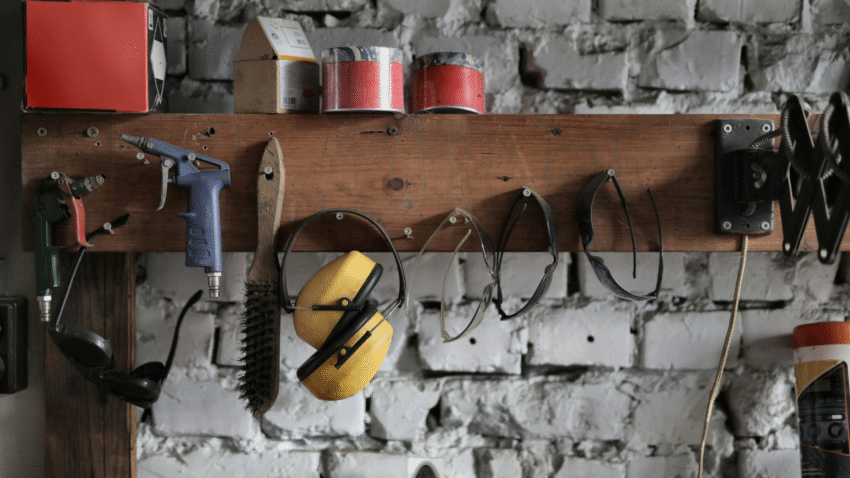Introduction
If your home doesn’t have a traditional mudroom, the garage can be the perfect place to create one. Learning how to create a DIY mudroom space in the garage will give you a designated area for shoes, coats, sports gear, and bags—keeping dirt and clutter from entering your living space. Imagine walking in from a rainy day and having a spot to hang jackets, store boots, and drop backpacks without tracking mud into your home.
Why a Garage Mudroom Matters
A well-designed mudroom in the garage is more than just a convenience—it’s a functional barrier between the outdoors and your living areas. It keeps dirt, snow, and water contained, reducing cleaning time and protecting your floors.
With the right layout, your garage mudroom can:
- Maximize storage with shelving, hooks, and cubbies.
- Improve organization for sports equipment, umbrellas, and seasonal gear.
- Enhance home value by adding a functional transition space.
- Create a cleaner entryway by containing mess before it reaches your main rooms.
Using tools like a workbench for shoe cleaning, pegboards for hats, and weather-resistant storage bins, you can design a mudroom that fits both your family’s needs and your garage space.
Step-by-Step Guide to Creating a DIY Garage Mudroom
1. Choose the Right Location
Select a spot close to the garage entry door leading into your home. This ensures the mudroom serves as a natural stopping point before you step inside. Clear the area of existing clutter, shelving, or tools to make room.
2. Measure Your Space
Before buying materials, measure the available wall length and height. This helps determine how many lockers, cubbies, or shelves you can install without overcrowding.
3. Install a Durable Floor Surface
Mudrooms see a lot of dirt, water, and heavy foot traffic. Options include:
- Rubber mats – slip-resistant and easy to clean.
- Vinyl flooring – water-resistant and budget-friendly.
- Sealed concrete – rugged and low-maintenance.
Tip: Avoid carpet—it traps dirt and moisture.
4. Build or Buy Storage Units
- Cubbies or Lockers – Assign one for each family member.
- Shelving Units – Great for baskets of gloves, hats, and scarves.
- Overhead Racks – Perfect for seasonal gear like snow boots or raincoats.
If you’re handy, you can build custom storage using plywood, MDF boards, and basic power tools. For a quicker project, purchase pre-made units that fit your space.
5. Add Wall Hooks and Pegboards
Install heavy-duty wall hooks for coats, backpacks, and umbrellas. Pegboards can hold smaller items like keys, hats, or dog leashes. Place hooks at varying heights so both kids and adults can easily reach them.
6. Create a Shoe Storage Area
Prevent dirt from spreading by keeping shoes in a designated area.
- Shoe racks – Keep footwear organized and off the floor.
- Boot trays – Catch water and mud from wet boots.
- Open cubbies – Allow airflow to prevent odors.
7. Include a Bench or Seating Area
A bench makes it easy to put on or take off shoes. Look for a storage bench with a hinged lid or built-in cubbies to maximize space.
8. Add Lighting and Ventilation
Good lighting makes it easier to find items quickly. Install a bright LED overhead light or motion-activated lighting. If possible, improve ventilation with a small exhaust fan or by adding an air vent to reduce musty smells.
9. Personalize the Space
Add a splash of personality with:
- Family name signs.
- Chalkboard or whiteboard for reminders.
- Color-coded bins for each person.
10. Maintain the Mudroom
Once your garage mudroom is set up, make a habit of cleaning and reorganizing it regularly. Wipe down surfaces, wash mats, and rotate seasonal items to keep it functional year-round.
Common Mistakes to Avoid
- Overcrowding the Space
- Problem: Too many storage units can make the area feel cramped.
- Solution: Stick to essentials and choose space-saving designs.
- Using Non-Weatherproof Materials
- Problem: Moisture can damage wood or fabrics.
- Solution: Opt for treated wood, metal, or plastic storage solutions.
- Not Providing Enough Hooks
- Problem: Items end up piled on the bench or floor.
- Solution: Install extra hooks to handle seasonal changes and guests.
- Neglecting Floor Protection
- Problem: Mud and water damage flooring.
- Solution: Use waterproof mats or trays under high-traffic areas.
- Poor Lighting
- Problem: Dim lighting makes it harder to keep organized.
- Solution: Install bright, energy-efficient lighting for visibility.
Extra Garage Tips & Hacks
- Add a Small Cleaning Station – Keep a towel, small broom, and cleaning wipes handy for quick clean-ups.
- Use Clear Bins for Seasonal Rotation – Store off-season gear in labeled bins and swap them out as needed.
- Install a Mirror – A quick glance before heading inside saves time.
For more inspiration, check out our article on maximizing vertical storage space in your garage to make your mudroom even more efficient.
Conclusion
A DIY mudroom in your garage is a simple yet transformative upgrade. It keeps your home cleaner, makes your daily routines easier, and provides a space for everything from muddy boots to sports gear. By following these steps—choosing the right location, using durable materials, and keeping organization simple—you can create a mudroom that works for your family year-round.
Pro Tip: Take a “before and after” photo of your garage mudroom project—it’s motivating to see how much functionality you’ve added to your home. Bookmark this guide so you can revisit it whenever you want to refresh or upgrade your space.
